

This Diamond Battery Can Be Powered By Nuclear Waste For 28,000 Years. Good vibrations: bladeless turbines could bring wind power to your home. The giant windfarms that line hills and coastlines are not the only way to harness the power of the wind, say green energy pioneers who plan to reinvent wind power by forgoing the need for turbine towers, blades – and even wind.

“We are not against traditional windfarms,” says David Yáñez, the inventor of Vortex Bladeless. His six-person startup, based just outside Madrid, has pioneered a turbine design that can harness energy from winds without the sweeping white blades considered synonymous with wind power. The design recently won the approval of Norway’s state energy company, Equinor, which named Vortex on a list of the 10 most exciting startups in the energy sector. Equinor will also offer the startup development support through its tech accelerator programme. The bladeless turbines stand at 3 metres high, a curve-topped cylinder fixed vertically with an elastic rod. This could be wind power’s answer to the home solar panel, says Yáñez.
Bill Gates's next-gen nuclear plant packs in grid-scale energy storage. Wind, solar, geothermal, hydro, wave energy ...
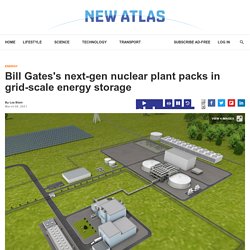
Renewable sources are a crucial pillar of any plan to decarbonize the world's energy generation industries and eliminate fossil fuel use. But for many reasons – intermittency, location dependency, land requirements, and others – they can't do it alone. To fully remove greenhouse gases from the world's energy sectors, there needs to be a cheap, scalable form of zero-emissions energy that can reliably produce power 24/7/365. All the better if it can rapidly ramp its output up and down to help the power grid cope with load spikes and interruptions in renewable energy supplies. The best candidate to fill this role right now is advanced nuclear power. While nobody wants their back yard to become synonymous with Chernobyl or Fukushima, nuclear is demonstrably one of the safest forms of energy generation. Natrium The Natrium plant is designed to run at 100 percent output, 24/7, outputting a constant 345 MWe in the form of heat.
Big oil invests in Eavor's "holy grail" pump-free geothermal loops. BP and Chevron have led a US$40 million investment round for a Canadian startup that claims to have developed a unique way to extract energy from geothermal heat on demand, using an unpowered looping fluid design that's already prototyped in Alberta.

Solar and wind are scalable renewable resources, but only produce energy when the sun and wind are up, not when the grid needs it. Hydro can respond well to demand, but it's not really scalable; the geometry of your dam dictates the size of your operation. Regular geothermal needs volcanic levels of heat, which restricts it to certain locations, the same way hydro needs mountain reservoirs. There are lower-temperature, low-enthalpy geothermal projects out there that can generate energy from hot rock in a flexible, scalable, on-demand fashion, but according to Eavor CEO John Redfern, these haven't taken off because they lose between 50-80 percent of the power they generate in the task of pumping the water up and down. Sugary droplets turn algal cells into miniature hydrogen factories.
Hydrogen holds great potential as a clean energy source, largely because it produces no CO2 and only emits water vapor when used in a fuel cell.
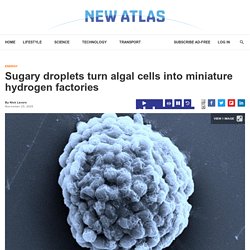
Most production, however, requires the use of fossil fuels, which has motivated much research into cleaner methods. A research team working in this area has made a discovery that could help these efforts along, demonstrating how algal cells can be turned into tiny hydrogen-producing factories by immersing them in sugary droplets. Scientists are exploring all kinds of avenues in an effort to make hydrogen production greener. One pathway involves algae, which naturally produces the gas albeit in small amounts. Genetic modification, harnessing certain algal proteins or attempting to recreate this process artificially are approaches that have shown promise, and now scientists from the UK and China have uncovered another technique with plenty of potential. Denmark strikes deal on £25bn artificial wind energy island. Denmark’s government has agreed to take a majority stake in a £25bn artificial “energy island”, which is to be built 50 miles (80km) offshore, in the middle of the North Sea.

The island to the west of the Jutland peninsula will initially have an area of 120,000 sq metres – the size of 18 football pitches – and in its first phase will be able to provide 3m households with green energy. It will be protected from North Sea storms on three sides by a high sea wall, with a dock for service vessels taking up the fourth side. In a broad deal struck on Wednesday night, the Social Democrat government agreed with its support parties and the rightwing opposition that the state should hold a 51% stake in the island, with the remainder held by the private sector. Powerpaste packs clean hydrogen energy in a safe, convenient gray goop.
Fraunhofer researchers have presented a magnesium-based "Powerpaste" that stores hydrogen energy at 10 times the density of a lithium battery, offering hydrogen fuel cell vehicles the ability to travel further than gasoline-powered ones, and refuel in minutes.
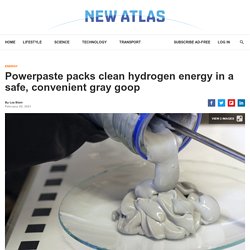
Lab-grown wood could let us grow furniture in a lab instead of in a fo. Electric car batteries with five-minute charging times produced. Batteries capable of fully charging in five minutes have been produced in a factory for the first time, marking a significant step towards electric cars becoming as fast to charge as filling up petrol or diesel vehicles.
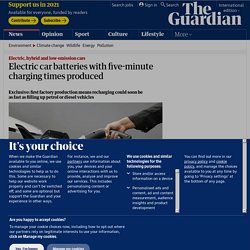
Electric vehicles are a vital part of action to tackle the climate crisis but running out of charge during a journey is a worry for drivers. The new lithium-ion batteries were developed by the Israeli company StoreDot and manufactured by Eve Energy in China on standard production lines. StoreDot has already demonstrated its “extreme fast-charging” battery in phones, drones and scooters and the 1,000 batteries it has now produced are to showcase its technology to carmakers and other companies. Kelp products could surround us in the future - but how sustainable will the industry be? The Norwegian coast is long, with cold nutrient-rich water.

It is well suited for kelp cultivation. In 2018, kelp farming in Norway reported a harvest of 178 tonnes. Already in 2050, however, harvest has been projected to reach 20 million tonnes. With a coastline at roughly 100 000 kilometres, it is safe to say that the potential for kelp cultivation in Norway is enormous. Chemists Turn CO2 Into Jet Fuel. Researchers have combusted chemicals and carbon dioxide into jet fuel hydrocarbons.By using the right catalyst and catalyst fuel, researchers save water.The process creates a circular carbon economy.
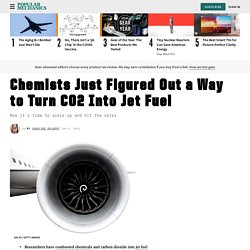
Between the COVID-19-related decline in air travel and increased scrutiny on airplane fuel consumption, it’s been a rough time for airlines. New catalyst converts common plastic waste into fuels and wax. As useful as plastics are in our everyday life, they’re difficult to recycle, meaning most ends up in landfill or polluting the environment.

Now, researchers in Japan have used a novel catalyst to recycle a common plastic into useful products like fuel and wax. By design, plastics are extremely resistant to chemical reactions. That makes them great for bottles and containers for chemicals, but on the flipside it makes them hard to break down when they need to be disposed of.
For example, thermal recycling processes, require temperatures of between 300 °C and 900 °C (572 °F and 1,650 °F), which obviously consumes a whole lot of energy. So for the new study, researchers at Tohoku and Osaka City Universities set out to find a new catalyst that could break plastics down at lower temperatures. The researchers say they were able to convert about 92 percent of the waste plastic into useful materials. Windfarms in Great Britain break record for clean power generation. Blustery winter weather helped Great Britain’s windfarms set a record for clean power generation, which made up more than 40% of its electricity on Friday. Wind turbines generated 17.3GW on Friday afternoon, according to figures from the electricity system operator, narrowly beating the previous record set in early January this year.
High wind speeds across the country helped wind power’s share of the electricity mix remain above 40% through Saturday. Coal and gas plants made up less than a fifth of electricity generated. Burning Iron for Fuel: Metal Powder as Renewable Energy. Bart van Overbeeke/TU Eindhoven After 300 years in business, a Dutch brewery is heating beer using sustainable iron combustion.Replacing high heat for furnaces or boilers has been a special challenge for renewables.Burnt iron is "recharged" for reuse using electrolysis that can come from clean energy sources. A brewery in the Netherlands is making environmental history by using a cycle of renewable iron as fuel for its furnace. Dive deeper. ➡ , starting NOW. A Ridiculously Huge New Solar Farm Just Came Online in China. The Chinese economy has suffered as a result of the pandemic, but one sector that’s forging full-steam ahead is energy. Last week saw the opening of a massive new solar farm—the second-largest in the world—in the northwest province of Qinghai.
The project is a collaboration between Chinese company Sungrow, which specializes in inverters for renewable energy sources, and the state-owned utility Huanghe Hydropower Development. Its 2.2 gigawatt capacity makes it second only to India’s Bhadla solar park, which opened late last year and has a capacity of 2.5 gigawatts. These both squash the US leader in solar power generation, which is currently the Solar Star farm outside Los Angeles. It uses more than 1.7 million solar panels to generate 579 megawatts of energy, enough to power 255,000 homes.
Ambrose Evans-Pritchard of The Telegraph writes that BP's move to green energy marks the end of Big Oil: With a single stroke of the pen, BP has written the obituary of the global petroleum industry. The Anglo-Persian Oil Company that once fuelled the British Empire and long defined Big Oil has confirmed what the technology fraternity has been saying for the last five years. Bells do not toll any louder than this.The two key scenarios released at BP's capital markets forum – at least the two that it believes in – tell us that world oil demand has already peaked forever near 100m barrels a day and will soon go into precipitous decline.It will fall by three quarters to 25m barrels a day by 2050 under BP's Net Zero forecast, mostly for plastics. Small Nuclear Reactors: Tiny NuScale Reactor Gets Safety Approval. NuScale's tiny modular reactor design has received a final safety evaluation report on its way to certification.The reactor isn't technologically new, but has a much smaller form factor and new safety system.There are several more steps, including public feedback and the final road to building NuScale reactors.
Nuclear startup NuScale has received a landmark final safety evaluation report (FSER) for its modular reactor design, making it the first American modular design to reach this point. NuScale’s design uses classic nuclear fission water reactor technology in a much smaller form factor, which contrasts with the escalating sizes of most current nuclear plant construction around the world. Oil companies wonder if it makes economic sense to continue oil exploration - Attention to the Unseen. Bloomberg reports: A few dots near the bottom corner of the world map in the southern Atlantic, the Falkland Islands were once at the forefront of a new era for the oil industry as companies scoured the planet for resources.Yet a decade after the discovery of as much as 1.7 billion barrels of crude in surrounding waters, the British overseas territory known for sheep rearing and tension with Argentina looks as remote as ever.
Scientists Turn Carbon Dioxide Into Ethanol. What Michael Moore’s new film gets wrong about renewable energy. In the film Planet of the Humans, producer and director Jeff Gibbs and executive producer Michael Moore take aim at renewable energy technologies and the environmental organizations such as 350.org and the Sierra Club that promote them. The film’s premise is that green tech is not so green and that turning to this technology as a cure for climate change would be worse than the disease. Scientists and environmental activists have already disputed many of the assertions in the movie, which was released on YouTube on April 21. 'Tequila' powered biofuels more efficient than corn or sugar. The agave plant used to make tequila could be established in semi-arid Australia as an environmentally friendly solution to Australia's transport fuel shortage, a team of researchers at the University of Sydney, University of Exeter and University of Adelaide has found.
The efficient, low-water process could also help produce ethanol for hand sanitiser, which is in high demand during the COVID-19 pandemic. New solar power source and storage developed. Image copyright Solivus. The Tiny, Simple Nuclear Reactor That Could Change Energy. An Oregon energy startup has a modular nuclear power reactor 1/100th the size of a traditional reactor and is supposedly far safer.The reactors can be installed in multiples to scale up or down to a location’s power needs.Traditional U.S. nuclear plants are reaching end of life, and the technology is simply outdated. Common element combos could replace rare-Earth metals in electronics. Converting waste plastic bottles into jet fuel. Atmospheric water harvester takes out $1.5m XPrize. Future 'Plastic' Could Be Made From Trees and Crab Shells. Scientists Are Working to Turn Algae into Diesel Fuel.
Untitled. The squares of silicon are hardly thicker than sheets of paper, each about six inches by six, with narrow stripes of silver. They come into the factory by the thousands, stacked in cardboard boxes, and within hours, they’ll be ready to leave again. The squares are solar cells, and in this plant two hours’ drive from Shanghai, workers in bright blue uniforms and white lab coats run the machines that assemble them, row by row, into more familiar-looking panels, ready to be installed on rooftops or in large arrays and begin turning sunlight into electricity. Chinese manufacturing has changed the economics of renewable power around the world, making solar generation cost-competitive with electricity from fossil fuels like natural gas and even coal.
Mercedes-Benz Energy teams with Vivint Solar to put batteries in US homes. "Artificial blowhole" generates electricity from ocean waves. Wind and solar power are becoming increasingly attractive alternatives to fossil fuels, but renewables are a rich tapestry, and the more threads we can weave together, the better. The Blob? First outdoor trial of genetically engineered algae conducted. Atlasobscura. Trashpresso Instant Recycling. Using sunlight to pull clean water from dry air. Scientists Turn Air Into Drinking Water With Device Powered Solely by Sunlight.
Theconversation. Stunning drops in solar and wind costs turn global power market upside down. California sun produces so much power that electricity prices turn negative. Canadian study: transition to renewables 'irreversible.' But U.S. needs to accelerate transformation. Citrus peels could give activated charcoal a run for its money. Insane Light System Blasts the Energy of 10,000 Suns. The Smokestacks Come Tumbling Down – The Nearly Now.
Project Sunroof - Data Explorer. Google's Project Sunroof highlights huge solar potential of US homes. How a 94-year-old genius may save the planet. Elon Musk offers to fix Australian power network in 100 days. Can the Goodenough lab invent the battery to jumpstart the electric car revolution? Tomato and egg waste may end up in your tires. Nanoparticles of rare metal and light convert carbon dioxide into fuel. Electrified fibers help pull uranium out of seawater. Energy-Free AC? Heat-Reflecting Wrap Could Cool Without Power. Long-lasting flow battery uses neutral water to keep costs low. Harnessing electricity-generating bacteria to clean up drinking water. New, long-lasting flow battery could run for more than a decade with minimum upkeep: Battery stores energy in nontoxic, noncorrosive aqueous solutions. Device Turns Air Pollution Into Printing Ink.
9 Weird Ways We Can Harness the Wind's Energy. Scientists Accidentally Convert CO2 into Ethanol, Potentially Solve Climate Change. New technique stores summer heat until it's needed in winter. HSBC peak oil report 2017.pdf. Electricity-free Egloo heater uses only candle power to warm a room. Old tires find new life as cleaner alternative to diesel. Flexible supercapacitor process brings phones that charge in seconds a step closer. Asian “super grid” the first step towards a global, interconnected, renewable energy grid. Reactor that produces liquid fuel from CO2 in the air to be tested in portable pilot plant. Mimicking nature turns sewage into biocrude oil in minutes.
DIY "junkyard battery" inspired by ancient blueprint stores energy cheaply. SAROS is a wave-powered off-grid desalination system. No One Saw Tesla’s Solar Roof Coming - Bloomberg. Meet the Scientist Turning CO2 Into Ethanol. Abundant silicon at the heart of cheaper renewable energy storage system. Reversing the combustion process to convert CO2 into ethanol. Elon Musk has a brilliant plan to kill ‘Big Oil’ The Fuel That May Halt The Electric Car Revolution. A Section of Route 66 Will Become America's First Public Solar Road. Solar-powered air-con uses heat to cool shopping center. Magnetic fridge eliminates gases, drastically reduces energy use.
The World Nears Peak Fossil Fuels for Electricity. Portugal runs for four days straight on renewable energy alone. Theconversation. Future - The secretive, billionaire-backed plans to harness fusion. Liquid hydrocarbon fuel created from CO2 and water in breakthrough one-step process. Sodium battery contains solution to water desalination. Renewable Energy Is Trouncing Fossil Fuels. How a New Engine Could Revolutionize Air and Space Travel. Self-Filling Water Bottle Converts Humid Air into Drinkable H2O.
Six energy records Britain broke last year. This Product Will Convert Leftover Food Into Cooking Gas For Poor Communities. Researchers develop fermentation process to produce biofuels from waste biomass. Billions in Change. Metal makes for a promising alternative to fossil fuels. Rechargeable paper sheets could help rewrite the book on electricity storage. Vortex bladeless turbines wobble to generate energy. Joule’s CO2-Recycled Ethanol Meets U.S. and European Specifications. Ricoh develops energy-generating rubber. Audi claims first synthetic gasoline made from plants. Audi just created diesel fuel from air and water.
HAUNTED MACHINES. Tesla unveils battery storage system for home, business and utility use. Have We Reached The Tipping Point For A Resource Revolution?